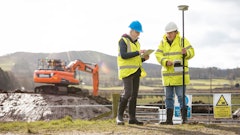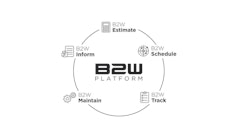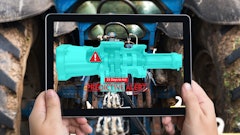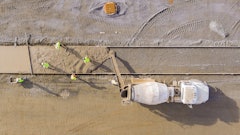
There is no shortage of mobile workforce apps for construction businesses. And all of them can replace slow, outdated processes with newer, faster ones. Most are inexpensive, and all run on devices your employees already know how to use.
Plus, if you choose the right app (or three), you could potentially save your business hundreds of thousands of dollars per year simply by running more efficiently.
With that in mind, here are seven ways mobile workforce apps can help you streamline your construction business, stay competitive and increase your bottom line.
1. Plug payroll holes with accurate time tracking
Approximately 20% of every dollar earned by U.S. companies is lost to employee time theft. That means that if you own a million-dollar company, $200,000 per year is slipping through the holes in your employee timesheets.
And while some of this time theft may be deliberate, other times it isn’t. Often, it stems from well-meaning employees who round up or down when tracking time on paper, arrive several minutes early to punch in or stay a few minutes late before they clock out.
Of course, there are also other, less scrupulous activities that contribute to the time theft problem, like punching in for buddies who are running late, taking long breaks while on the clock or using work time for personal errands.
But, no matter the reasons, the costs add up.
Now, here’s the good news. There are time tracking apps for construction businesses that can, among other things, reduce the opportunities for your employees to flub their time sheets.
With features like GPS tracking and geofencing, you can be sure that your employees are exactly where they are supposed to be. And time stamps let you know exactly what time they arrived. You can even see the routes they drive while on the clock, so you know they aren’t spending company time running personal errands.
Read next: How Time-tracking Technology has Rendered Time Sheets Obsolete
And, on the flip side, these construction time tracking apps assure your employees that they’re always being paid exactly what they’re owed. And these apps can even send alerts once employees are on-site to remind them to clock in and avoid errors that could cost them as well.
So, adding a time tracking app to your workflow is a win/win that could potentially save you hundreds of thousands per year.
Some time tracking mobile apps include:
2. Cut down on costly rework with improved field communications
According to a 2018 industry report, U.S. construction companies spent over $65 billion on rework. And $31.3 billion of that rework was caused by miscommunication and data mismanagement. That means that over half — 52% to be exact — of all rework could be avoided if communications were improved.
And mobile workforce apps can help you do just that. In fact, there are several apps created to improve communications specifically within the construction industry. Some are simple chat apps that work across all devices and keep your communications in searchable folders. Others are more in-depth construction management platforms.
But the common thread that runs between them is this: they allow you to alert field crews of any changes in real time — before the wrong work gets done.
Some communication focused apps include:
3. Stop department silos by syncing the office and the field
A great by-product of being able to communicate with your field teams in real time is that they can also communicate with other departments, especially the office.
Traditionally these two departments have been siloed off from one another. But mobile construction apps now make it possible for the field crew and the office to better collaborate.
For instance, field crews can document the work they’ve completed inside an app, and the front office can access it immediately. This ensures that the office has the information it needs, not only to handle payouts but also to handle any audits that might arise.
4. Keep stakeholders better informed and working well together
The ability to communicate in real time also keeps important stakeholders abreast of what’s going on within an entire project. So instead of owners, managers and supervisors butting heads because one doesn’t know what the other is doing, they can each see the project as a whole. Then they can work together and make better decisions.
5. Digitize paperwork and get more construction work done
Here’s another great benefit that comes with mobile construction apps: they make it easier and less time consuming for your field crews to create fully customizable reports — while they’re in the field. So they don’t have to wait till the end of the day and leave the site to fill out forms.
That means they can spend more time doing the construction tasks that move you toward a finished project and less time chasing down and filling out paperwork.
Some field reporting apps include:
6. Track and manage construction assets
Construction asset management apps use GPS to help you keep track of where your tools and equipment are. There are apps that specialize only in monitoring your construction fleet. And there are other apps that help you track all your tools and equipment.
These asset management apps can alert you of a possible theft, tell you when it’s time for service and help you keep track of the costs associated with an asset for its entire life cycle.
Some asset tracking apps include:
7. Improve workers’ safety
Construction sites can be dangerous places. In fact, according to OSHA, one in five of all worker deaths reported in 2018 were in the construction industry.
So it’s no surprise that there are construction apps dedicated solely to improving jobsite safety.
With these apps, your employees can have easy access to safety data sheets and inspection checklists. So they can have the safety information they need when they need it. And they can document any safety concerns they see in real time. Then you can get any issues resolved before someone gets hurt.
And as a bonus, these construction safety apps make complying with OSHA’s new e-filing rule much easier.
Some construction safety apps include:
There are plenty of mobile workforce apps for construction that can help you streamline your operations. And whether your construction company needs to improve safety procedures, plug the holes in your payroll or improve overall communication, an app might be the best way to do it.
Holly Hughes-Barnes writes for ClockShark, a leading time tracking app for construction and field services. Hughes-Barnes is a B2B copywriter with over 20 years of construction and real estate experience. She writes authoritative blog posts, case studies, and ebooks that build trust, bring in leads and make more sales for the companies that she’s privileged to work with.





























